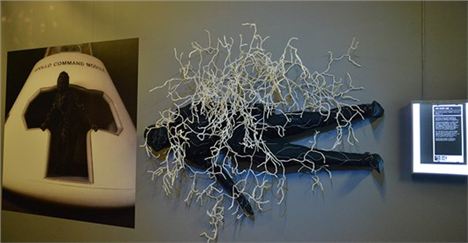Why a joint review? It’s quite straightforward really. There’s a good deal of synthesis between the two digitally-influenced experiences in terms of the human condition in a virtual universe. Themes such as “what makes us human” and “multiple identities” are evident in both – particularly where the imagination allows for the potential dystopia of post-digital age. Let’s deal, firstly, with The Grid.
This was the inaugural production for the collective talents of the Young Everyman Playhouse in the new acting space.
Every member of the ensemble played a part in devising their characters and the eventual script came together under Alex Joynes and Laura Kate Barrow and the directors Chris Tomlinson and Matt Rutter. Their aim being to embed youth theatre into the very beating heart of the new Everyman following on from similar ventures like Paper Town back in 2012.
The main plot is introduced through a series of mini-lectures and video clips which establish the basic premise that the future human-digital interface will dispense with hardware completely. All users will be part of the Grid, thanks to the insertion of a chip. Everyone is connected – all knowledge is shared, all possibilities limitless. However, this utopia soon turns sour when it begins to fail. Collective paranoia ensues as users becomes marooned in something entirely new – real life and relationships…the shackles of humanity within itself.
This gives ample scope for dynamic character interaction through a series of cameo’s, vignettes and occasional choreographed set pieces exploring the “what if’s” of absent VR and CGI. These include the chance meeting-up of Metal Casket Warriors as fiction became truth, a new take on the game of “I-Spy” and a ball-bouncing anti-hero who declares a vital affirmation of existence. Evident correspondence, here, between McGoohan’s Number 6 and his declaration of individual freedom against a forced oligarchic utopia.
These worked individually as a series of living snapshots but needed a framework to bind them together and, at times, there was a tangible sense of isolation and loneliness as bad as fretting over those email/texts which never came.
Overall, like binary code itself, audience reaction is stored and processed on whether something is there or it’s not. Something was definitely “there” in YEP’s Grid production where a new generation of performers used their collective imagination to explore the human condition – what makes “us” human. For below the sun, moon and the stars, that’s what we all are. The Everyman Youth Theatre must be given credit for the way they handled this in such an innovative and refreshing way, full of zeal, energy and passion – they truly are the Wizards of Us.
What, then, do we make of Science Fiction: New Death at FACT? Well, according the joint curator’s Mike Stubbs and Omar Kholeif, the exhibition is there to make us think, perhaps for the first time, about the implications of real/virtual identity and paradox of self-obsession in an ever-present world of instant online media.
The title is taken from China Mieville’s “The Condition of a New Death” and acts as a metaphor for a “call for a manifesto to be written”. If so, this future-orientated manifesto is multi-faceted, ranging from an installation where you can experience zero-gravity to a series of blank mortuary-like cabinets and an organic body suit within which you simply melt away. You can, also, include the series of masks designed to confuse facial-recognition security software, an intriguing pod capsule with a stuffed cat and Atari-like video graphics and a collection of highly intricate architecturally-inspired drawings which could well have been Metropolis on quaalude.
In essence, this exhibition isn’t about death at all. It’s an intentional paradox as it calls for a rethink about, yes once again, what it means to be human within an increasingly diverse range of digital identities. Where the Everyman’s YEP was a live performance of collective effort, FACT presents a diverse range of deeply thought-provoking visual experiences. They share a common perspective which questions our relationship with the new digital deities. In an age of the selfie, where does the self actually exist? Where The Grid implanted instant universal connectivity within the human frame, this exhibition dispenses with the body itself to explore the potential fields of creative imagination. It’s very much “la petit-mort” rather than “mort” itself.
Within that, imagination takes centre-stage which is, also, crucial to the appreciation of the science-fiction context within which exist limitless possibilities. Good to see the contribution made by the Science Fiction archive from the University of Liverpool and a splendid collection of pulp material. Credit, also, to the exhibition’s designers from the Kazimier – bodes well for future collaborations. A visit is highly recommended and when you do, pick up a free copy of The Hitchhikers Guide to the Gallery [courtesy of Freehand Connects] which is a strand of FACT’s young people’s programme.
Science Fiction: New Death at FACT
27th March-22nd June 2014















